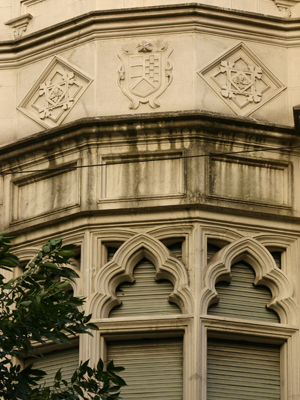
Estanislao Pirovano’s most prolific style, Neotudor or Tudor Revival found fans around the world. I even found lots of it in Bogotá. Popular roughly during the same time as Art Deco, architects replicated simple, English country homes & often added local influences to make an eclectic mix. Pirovano excelled at combining four-centered arches, wooden doors, bay windows, fanciful columns, faux coats-of-arms & mythical/real beasts… very unique in Buenos Aires & something upper-class porteños wanted.
Riobamba 1959 (Recoleta) • The Escuela Argentina Modelo is a fancy private school that Pirovano built with his brother in 1926. He literally signed all his buildings… making them easy for us to identify in the 21st century. Frilly, Plateresque concrete figures above the main entrance are a recurring feature of Pirovano’s work. He obviously liked dragons & other mystical creatures.
In a school named after the nation, of course the sun on the Argentine flag is incorporated into the decoration. Several suns stare down from window archways. And the school’s logo sits high on the façade. No clue why they chose a ship to represent the school, but a stylized boat made out of the initials “EAM” frames a more accurate depiction in the background. They guard the school like it was Fort Knox, so I doubt I could ever get inside. There are some spectacular interiors on the school’s webpage even if the photographer got a bit carried away with the fish-eye lens.
Anchorena 1314 (Recoleta) • Dating from the early 1920’s, this building used to be part of the Universidad de Palermo then the Angolan embassy. In 2007, the embassy closed & the building was put on the market. Fortunately saved from demolition, today it belongs to NYU as part of their foreign study program. Check out their campus photos… what a fireplace!
Pirovano made added more Tudor elements than on the Escuela Argentina Modelo. Exterior brick is something not often seen in Buenos Aires, & the upper window treatments are gorgeous. Of course, he signed this house too. But Tudor isn’t the only revival going on here. There are hints of Neocolonial (particularly in the column reliefwork), another revival style which Pirovano would wholeheartedly adopt later.
The decoration above the main entrance is similar to that of his other Tudor Revival houses. Detail has faded with time, but it looks like a soldier wearing armor is about to fight an indigenous person carrying a bow & arrow. What’s even more bizarre is that instead of a crown above the coat-of-arms, it’s a feather headdress. What the heck was Pirovano or the original owner trying to say? Not very PC of him.
Ayacucho 260 (Balvanera) • Built around the same time as the NYU campus, this building shares some of the same features. No exposed brick or relief above the main entrance, but it’s trademark Pirovano. All you really have to do is find the signature behind the tree. The entrance is eye-catching even without a relief… find the decorative columns, wooden doors & some nice knockers. The central design incorporates a lot of Neocolonial elements into the overall Tudor look. Swirls & shields mix with blocky borders, stepped like a ziggurat. I wish there was a way to see the stained glass from the inside. Originally constructed as a private hotel for Nicolás Celesia —no clue who he was, but he must have had cash to spare— it was trashed on the inside by the SUTERH union. At least it’s still there.
Guido 1760 (Recoleta) • Although less decorative & smaller than some of his earlier buildings, Pirovano designed this petit hotel for Catalina Olivier de Premoli in the late 1920’s. The similarities between this petit hotel & the one on Ayacucho (above) are obvious, but each has a very distinct character. Currently a Spanish consulate occupies the site, hence the gigantic Spanish flag. It’s beautiful, but there isn’t much that jumps out & grabs your attention. The architect’s signature is barely visible. You have to stare a long time to realize that it’s above a light fixture… probably the result of restoration work that painted over the fine details:
Talcahuano 1261 (Retiro) • One of Estanislao Pirovano’s first buildings is open to the public because it’s currently used as a public library, the Biblioteca Ricardo Güiraldes. More early 1920’s Tudor Revival to enjoy. His signature is a bit different here… it’s in relief rather than engraved.
The façade shows typical Pirovano decorative features: a touch of Neocolonial in the columns plus a grand relief over the main entrance with coats-of-arms & bizarre animals. What’s a bit different here are the windows. Sets of extended, overlapping trefoil arches mix with what I’ll term quintefoil arches. Making up new words is fun. Call them what you like, they add extra punch to the façade. I loved the fact that I could step inside, even if it was just the first room. Note the black & white checkerboard tile on the floor & that amazing carved wooden door.
When I walked through the door with my camera, the security guard gave me the standard frown. So I gave her my standard bit about liking architecture & obvio, no soy de acá. Add a smile & it works every time 😉 She told me that photos weren’t allowed, but I could take some as long as the staff didn’t see me. Sweet gesture but the front room was so cramped that I couldn’t really take any pics at all. Two small stained-glass windows were above a bookcase, & the staircase was to die for. No amount of photoshopping could save the interior pic, but it was the best I could do.
Cabello 3830 (Palermo) • A poorly compiled list of Pirovano’s buildings tipped me off to a possible house near the Eva Perón museum. I walked around the general area hoping to bump into something. It didn’t take long. The following building has all the tell-tale signs of Pirovano. The top left pic is from the BsAs map site; the second is the state in which I found it. Seeing the tall barricades, demolition might be imminent. The frontpiece on the bay window is missing, & all the windowpanes have been removed. I got closer to see if I could find Pirovano’s signature… nope. It’s missing too. Guess there wasn’t room for him to sign this building. But two other characteristics gave me all the proof I needed (highlighted below): the same scallop-shell tracing & square block motif as on the NYU campus. There are no imaginary creatures or dragons, just two majestic lions. The cloverleaf background is a nice touch. Fortunately there was a hole in the barricade small enough to fit my camera lens. The interior looked barren except for a lone bottle of Quilmes.
Two building supers nearby were chatting to each other, watching me take pics. They are always good sources of info, so I asked if they knew whether the building was being demolished or set to be converted into something else. Ni idea. They said that work had stopped a couple months ago & no one knew why. Anyway, no sign, no workers & no one knew what was going to happen. But they added that a few months ago when the building was sold, a guy came around (someone you could tell had a lot of money, they claimed) & ordered the removal of all the stained glass, light fixtures, floor tiles… everything. And so now the building sits there, stripped of all its ornamentation that could be resold. They seemed to think that it wouldn’t be demolished… I hope they’re right.
In Feb 2011, I was in the area & decided to see what had happened since I wrote the original post. I wish I hadn’t gone. It’s now a mini-market… lions covered with signage, windows destroyed & cemented over, interior completely ripped out. I often get sad when I see this kind of disregard, but this time I got angry. I’m still pissed.
Update (02 Oct 2011): After a recent trip to San Miguel de Tucumán, a descendant of the Helguera family requested a remake of the family home done in a similar style. Did Spanish architect José Graña copy willingly? Did Pirovano know his intellectual property was in danger? Lots of investigation to do, especially since the Tucumán building contains more Neocolonial elements than Neotudor… stay tuned.
Estanislao Pirovano series: Biography • Neotudor • Neocolonial • Neoprehispanic • Unbuilt • Last word

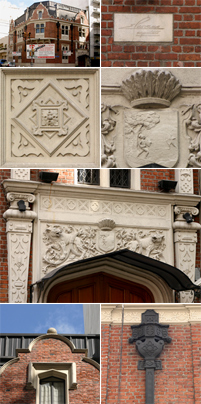
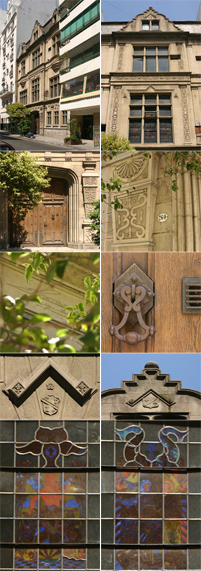
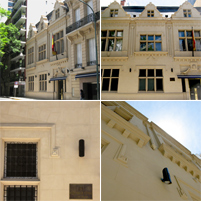
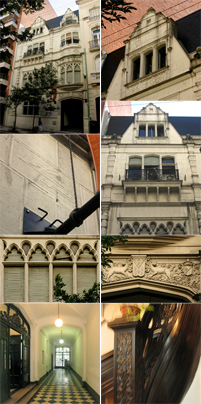

Excelente trabajo de investigación y documentación. Estoy disfrutando muchísimo ésta serie sobre Pirovano. Es como una película! Momentos detectivescos con la investigación en la Universidad de Glasgow, y momentos tearjerker como el destino de super chino para la otrora hermosa casa en Palermo.
Gracias Antonio! Sí, todo un drama, no? Tiene para todo el público 🙂 Ya escribí al Otto Krause y me contestaron mal… deberia agregar ese dato al relato. Te mando un abrazo!